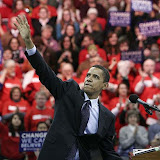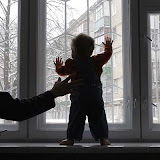It's a curious feeling to stand at the epicenter of a disaster. On April 26, 1986 in the middle of the night, in Control Room 4 of Chernobyl, things went wrong during a test. Very wrong. The rest is, as they say, history. Plenty of books have been written and decades of debate about what exactly went wrong and who was to blame.
But I just want to tell you about the experience of actually standing in the half-dark, half-destroyed room, dosimeters on, taking it all in.
View of Chernobyl's dark Fourth Block Control Room, where the 1986 accident began. This panorama was created by stitching together 12 photographs. (Click to see larger).First comes anticipation. It took me two years of working on this Chernobyl documentary to get here. We got our security clearances, crossed the border twice today, and passed five different checkpoints. We put on our protective clothing. I work for an hour photographing in Control Room 1. All the time we are getting closer to Ukraine's ground zero and I wonder what will we see.
Then comes fear. Some people think I am crazy to go inside Chernobyl, but the working areas have been cleaned regularly for two decades and are no longer dangerous. So my first flicker of fear came only when we paused outside Control Room 4 to pull rubber slippers over our protective boots. How puny we are, I thought, in the face of such a monumental disaster. We are entering the enormous Sarcophagus, the shell constructed to contain the radiation. Here or anywhere, I wonder, why do we live our lives believing that we are safe from harm?
Next comes surprise. We enter. It is dark. One security light high above casts one small pool of light. My first thought is that it doesn't look real. It looks like a stage set, the house dark. Or a movie set. The bridge from Star Trek. Control Room 4 once looked similar to Control Room 1, but no longer. The first block control room is still alive: it has lights, workers, ceiling panels, a pen holder on a desk, a fridge for lunch food, office chairs with wheels. Everything has been stripped from the Fourth Block.

A central panel of the Fourth Block controls.On the other hand, the room is not burned out. Somehow, I expected charred concrete and twisted metal. There is plenty of such debris at Chernobyl, but not here. The control room was protected by a 3-meter reinforced concrete wall. Even though there was an enormous explosion in the reactor, just 5 meters north and 15 meters below us, this room was spared. The nearby reactor hall and turbine hall remain too radioactive and unmapped to allow any visitors inside.
I'm also surpised that the control room, which I always imagined as an isolated place, now serves as a hallway for workers. The original corridor, on the other side of the reinforced wall, is too contaminated for use.
Next, a moment of panic. My rubber slipper falls off, and I suddenly feel naked. I envision the invisible radiation drilling holes through my foot. Of course, to my escorts, it is a minor matter. They tell me to simply pull it back on, reminding me to put on my gloves first. Later, they tape my boot on, mostly, I think, just to make me feel better.
Next comes a sense of solemn awe. Hundreds of thousands of lives were changed forever because of what happened in this room. More than that, the very course of world history changed. The Cold War ended because of Chernobyl. Even the Soviet Union itself ended because of Chernobyl: after the accident, people lost faith in their government, protests began, and the whole system crumbled. Like 9/11, Chernobyl marked the end of an era. Afterwards, nothing looked the same.
 We look at the hole in the reactor control panel where the 3 big red emergency buttons used to be. (Yes, they really were red. But most of the buttons and controls were long since stripped during decontamination). Here, on 4/26/86 during the 41 seconds between 1:23:04 AM and 1:23:45 AM, an operator desperately hit these buttons to insert all emergency shutdown rods back into the reactor. But it was too late.
We look at the hole in the reactor control panel where the 3 big red emergency buttons used to be. (Yes, they really were red. But most of the buttons and controls were long since stripped during decontamination). Here, on 4/26/86 during the 41 seconds between 1:23:04 AM and 1:23:45 AM, an operator desperately hit these buttons to insert all emergency shutdown rods back into the reactor. But it was too late.Finally comes anxiety. Time is passing quickly and I have work to do. This is a very dark and very large room, and I brought just one off-camera flash to light it, since I was advised to carry as little as possible into the dirty zone. I jump into working, leveling my plastic-wrapped tripod and directing my voice-activated light stand (AKA Sergii), and there is no longer room in my head for thinking about the implications of this space.
After we emerge, I study a model of the plant. I can't quite believe we were inside the belly of the beast. And I am also amazed how low our radiation dose was. We received just 0.007 milliSieverts of radiation during our hours inside, about what you'd get on two hours of a transatlantic flight.
Chernobyl has gotten inside my head. Although my photography mostly focuses on people, it is important to include the epicenter from which all other effects radiate. I'm grateful to have this opportunity.
During my interviews, I've realized that what Chernobyl means to people says more about them than about the disaster. Some discount it entirely. Some mourn for a paradise lost. Some fear it. Some blame it. For me, when I started, Chernobyl was a lingering danger that needed to be uncovered. And now? I'll get back to you on that.



